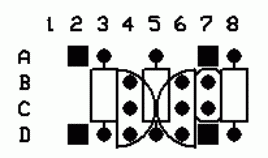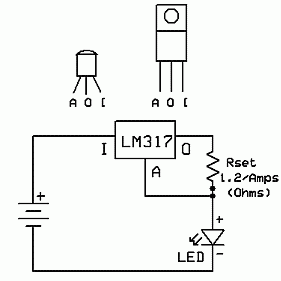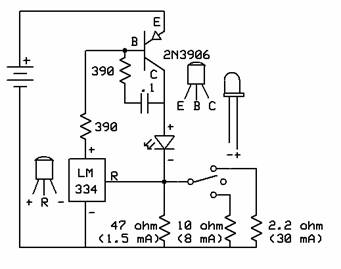This drawing shows
the numbering of the holes.
It shows the pictorial view as seen from the top.
The squares at A2, D2, A7 and D7 are flea clips.
|
 |
This drawing is again the
top view, this time showing the connections to the flea clips.
|
 |
This drawing is the bottom
view of the perf board.
The holes are numbered as seen from the bottom.
The heavy black lines are the component leads.
|
 |
| This is the current schematic
for the Boost converter. The negative power is connected to the emitters
and LED cathode. With the values shown, the circuit draws about 18 mA
and drives the LED to 5 mA or so. Higher input voltage, up to 3 volts
assuming white LED use, pulls more current and therefore produces more
light. Changes in values will change performance. Attention should be
paid to the inductor, as it is the key in most cases. It needs to be capable
of dealing with peak currents and not saturating. |
 |
| This drawing is the LM317
based regulator circuit. |
 |
This is the schematic for
the Low Drop Out (LDO) regulator circuit based on the LM334. The transistor
boosts the available current (limited to 10 mA by the IC) to higher
levels needed to drive the LED. In the example above the 47 ohm resistor
(which is always in circuit) sets a basic current of about 1.5 mA. When
the switch is not in the center position (open circuit) either the 10
ohm or 2.2 ohm resistor is put in parallel with it, raising the total
current. This gives low, medium and high levels, each regulated.
Click
here for more about this circuit. |
 |
This is the schematic for
the Low Drop Out (LDO) regulator circuit based on the LM334. The transistor
boosts the available current (limited to 10 mA by the IC) to higher
levels needed to drive the LED. The regulator (the LM334) compares the
voltage between it’s R and minus leads (caused by the voltage
drop across the current set resistor as a result of the actual LED current
at that point in time) against an internal reference of approximately
.065 Volts. It then drives the transistor more or less to correct the
LED current to match the preset value. Thus LED current stays constant
for changes in battery or LED voltage. The value (in ohms) needed for
any given current is .065 divided by that current (in Amps).
Click
here for more about this circuit. |
 |
| |